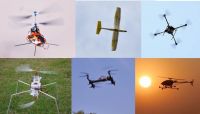Research
Research » Research
Our group's main focus is on rotary winged vehicles aka Helicopters, their cousins (VTOL) and their other family members such as Wind Turbines. We are part of the Helicopter Lab where we are trying to solve some of the fundamental problems associated with the development of autonomous unmanned aerial systems (UAS), futuristic Vertical Take-off and Landing (VTOL) capable air vehicles and Wind Turbines. Apart from the MAV related work, we are also actively involved in barrier problems associated with Helicopter dynamics, aerodynamics and flight dynamics. Focus is on the development of state-of-the-art tools to be used in industry for the design of future generation helicopters with the aim of attaining self reliance in helicopter analysis and prediction capability.
High Efficiency Dissimilar Coaxial Rotor Concept
A novel dissimilar coaxial rotor concept with significantly reduced rotor-rotor aerodynamic interaction has been proposed and studied. The proposed concept with reduced RPM of anti-torque rotor is predicted to consume 10-15% less power than equivalent conventional rotor without any tail rotor. The inclusion of tail rotor power for comparison of the performance of dissimilar rotor as an anti-torque concept shows a power reduction of 7-30% when compared to a single main rotor-tail rotor configuration. The analysis also predicts 10-12% less power consumption for dissimilar coaxial rotor design, when compared to a regular coaxial rotor. The proposed concept appears to be an efficient alternative to conventional tail rotor for hovering flight condition. Experimental studies are planned to further establish the advantage of this novel rotor configuration.

High Efficiency VTOL Quadrotor Convertiplane
Goal is to carry out design, development and flight testing of a small novel hybrid quadrotor convertiplane Unmanned Air Vehicle (UAV) which has four propellers driven by individual motors mounted at the tip of tandem wings. The segment of the wing under the propeller downwash is tilted with the propeller to improve the hovering efficiency of the UAV. Tandem low fore and high aft wing design is chosen to mitigate the interference losses due to the influence of fore wing and propeller downwash on the aft wing and the propellers. The current design offers significantly higher efficency than existing quadtiltrotor concepts by eliminating the download penalty. The prototype has been fabricated and flight tested in hover. The autopilot for conversion flight is under development. This concept would be eventually developed into a personal air vehicle (PAV) / Air taxi system.

Design and Developement of Mini Compound Rotary Wing Unmanned Aerial Vehicle (CRUAV)
Objective is to design and develop a model scale compound helicopter Rotary Wing Unmanned Aerial Vehicle (RUAV). For this, first, a rotorcraft dynamics formulation is developed and validated. Next, a design trade study is carried out to identify the baseline design parameters for compound RUAV. The rotorcraft dynamic model is then used to carry out performance prediction and analysis of model scale RUAV. Next, it is then refined by incorporating the baseline design parameters of wing, propellers and horizontal stabilizer in the trim analysis to enable performance prediction of a compound RUAV. Finally, the performance benefits offered by the compound RUAV configuration is compared and contrasted with that of the conventional RUAV. With the knowhow generated from theoretical analysis, a 10 kg class compound helicopter would be developed.

Remote Controlled Boomerang
We have developed world's first remote controlled boomerang. The design is inherently stable in hover and does not require any autopilot. By design the vehicle flies only in circles of different radii which can be controlled by the pilot. Work is underway to develop the flight dynamics model for fundamental understanding of the concept.
Design and Development of a Biplane Quadrotor Tailsitter VTOL Airplane for Payload Delivery
The proposed design of a quadrotor biplane tailsitter Vertical Takeoff and Landing (VTOL) Airplane aims at combining the speed and endurance of a fixed wing UAV with the VTOL and hovering capabilities of an agile variable pitch quadrotor to come up with a new design which can address several of the challenges discussed above. A variable pitch 'H' shaped quadrotor design is combined with two fixed wings attached to the parallel limbs of the quadrotor to result in a biplane tailsitter aeroplane. The vehicle can take-off and land vertically and hover in helicopter mode before transitioning to fixed wing mode to fly with good fuel economy like an aircraft. Some of the key aspects of design are:
- use of variable pitch for changing the thrust over each rotor instead of RPM change for superior agility and higher controller bandwidth
- introduction of two fixed wing in biplane configuration for compact size and better cruise efficiency
- use of fuel engine for longer endurance
- variable rotor speed for optimal hover and forward flight performance


Design of Vertical Axis Wind Turbine with Variable Amplitude Pitch Change and Aerodynamic Braking
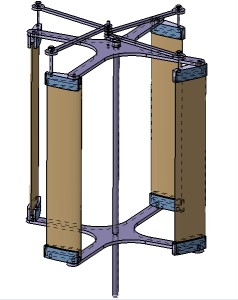
Vertical Axis Wind Turbines (VAWTs) appear to be an attractive option due to their compactness. However, the fixed pitch VAWTs are not very efficient. Goal is to address these issues by desiging a variable pitch wind turbine and bring in innovations to provide consistent performance over wide range of wind speeds, irrespective of the wind direction. A lab scale prototype has already been fabricated and wind tunnel tests are being planned. In addition, double multiple streamtube based analysis has been developed to characterize the performance and size the turbine for household applications. See the video of first lab scale prototype in action. For more information see Renewable Energy, Vol. 97, November 2016, pp. 97–113, doi: 10.1016/j.renene.2016.05.056
Project NAAVIK (Navigation for Autonomous Aerial Vehicles by IIT Kanpur)
NAAVIK is India's first cross platform / vehicle autopilot project meant for UAV / MAV applications being developed at IIT Kanpur's MAV laboratory. It is developed on ChibiOS RTOS (Real Time Operating System) for NAVSTIK, Aeroquad 32 and Pixhawk autopilot hardware boards which are among the lightest open source autopilot hardwares out there.
NAAVIK has already been tested on a fixed wing UAV for fully autonomous flight. It has also been tested on coaxial MAV, flapping wing MAV, Quadrotor and now on Mini Helicopter (single main rotor and tail rotor type). Objective is to develop NAAVIK for application on wide range of UAV platforms. The features offered by NAAVIK include:
- Loiter: at specified altitude, circle radius and location (lat, lon).
- Straight line path following: between any number of points (can specify different altitudes).
- Height hold, position hold.
- Return to home on loss of radio contact.
- Auto landing for VTOL vehicles.
Below is a video of its application on Quadrotor.
NAAVIK auto-pilot has now been tested and proven on a flybarless 700 class helicopter Align T-Rex. Attitude stabilization, height hold mode, translational rate command, GPS based position hold mode and way point navigation capability has been implemented and tested.
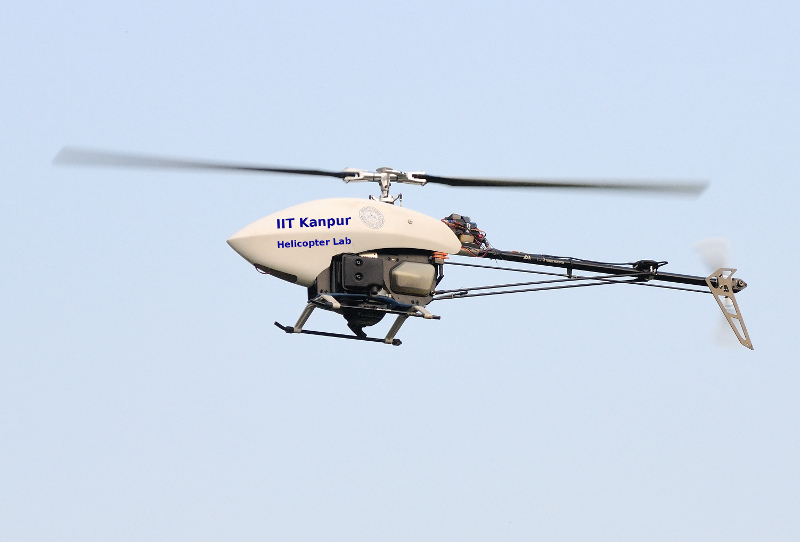
For rotary wing UAVs, NAAVIK offers the following features:
- Rate Command Attitude Hold (RCAH)
- Attitude Command Attitude Hold (ACAH)
- Altitude Hold (AH)
- Translational Rate Command (TRC): Stick movement controls velocity of the vehicle
- Waypoint navigation mode: follows predefined waypoints (see video below for demonstration)
IC Engine Powered High Endurance Quadrotor
Goal is to make a quadrotor powered by IC engine for greater payload and longer flight times. A proof-of-concept single powerplant (single motor) powered vehicle has already been designed and flight tested. The engine powered version is under development.
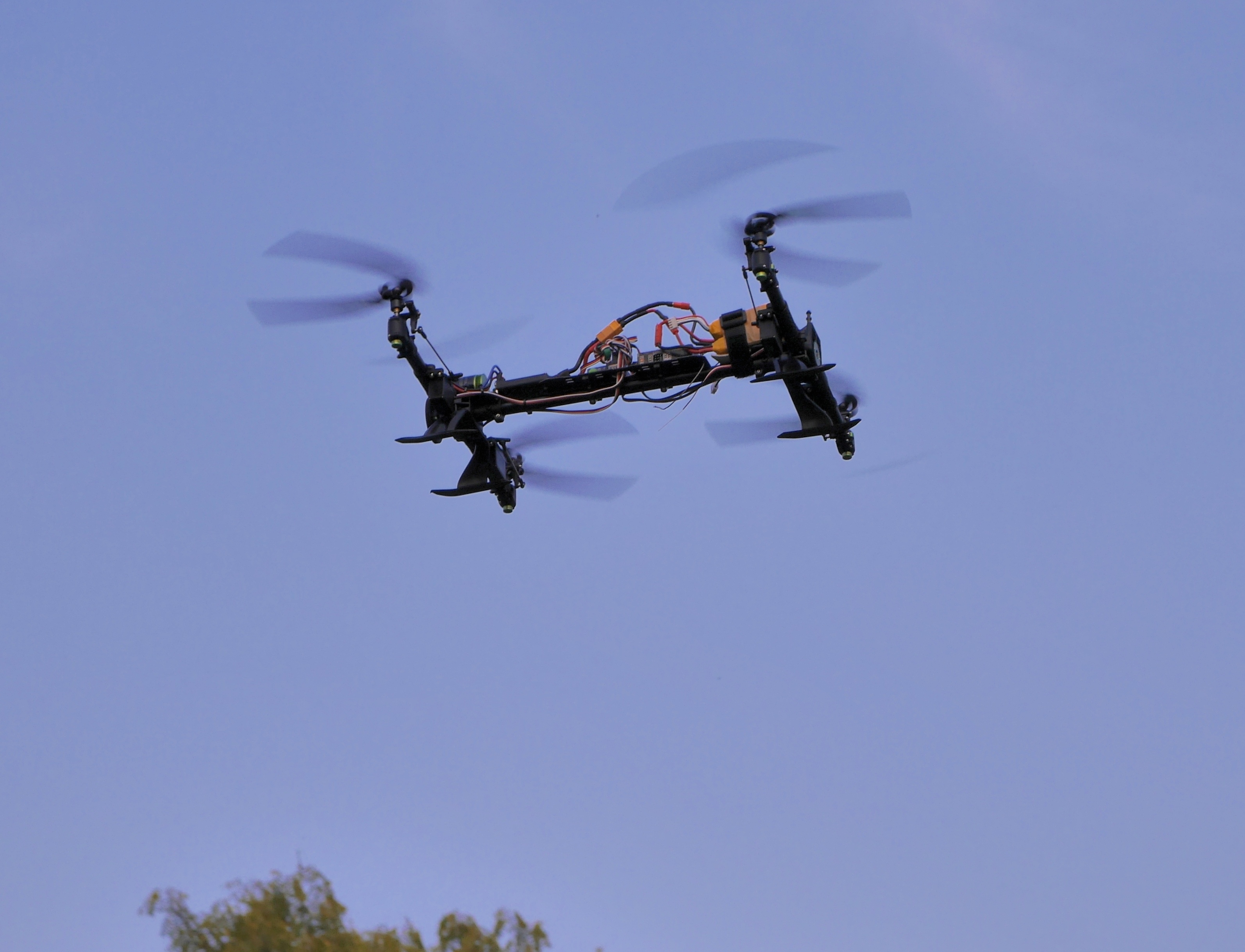
Below is the video of demonstration of waypoint navigation and auto landing on a variable pitch quadrotor.
Micro Coaxial Autonomous Heli (MiCAH)
Goal is to develop a hover capable, autonomous Micro Air Vehicle. The desired characteristics include capabilities such as auto-take off and landing, autonomous hover with velocity and position hold followed by autonomous flight with way-point navigation. The platform chosen for this work is a Coaxial Micro Air Vehicle instrumented at IIT Kanpur (see image below) using optic flow sensors, IMU, infrared sensors and SONAR. The above milestones would be achieved in a step by step manner. Significant progress has been made in the autonomous take off capability as well as autonomous hover using velocity feedback.
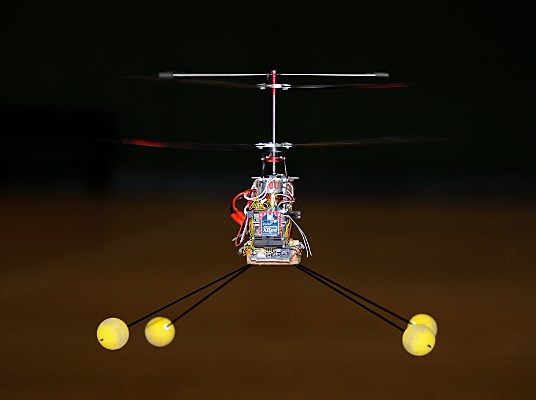
Autonomous Hover
A video showing MiCAH performing autonomous hover with "velocity" feedback obtained from a combination of Optic flow + IR sensor is included below. Currently work is underway to characterize the vehicle dynamics for improved hover performance.
Design and Development of Coaxial MAV
MAVs are aerial robots, as six-degree-of-freedom machines whose mobility can deploy a useful micro payload to a remote, constrained or otherwise hazardous location. Goal is to design and build as well as analyse a coaxial (counter rotating twin rotor) hover capable Micro Air Vehicle (MAV). Image below shows the conceptual design of the vehicle.
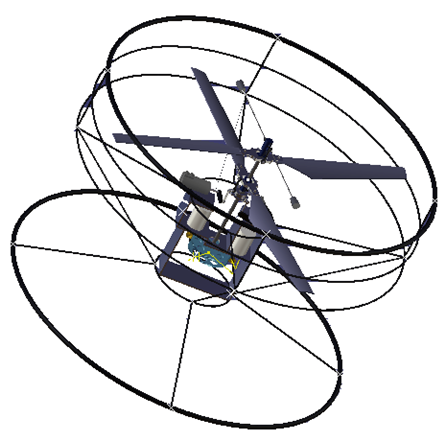
And this is how the real thing looks like. Several prototypes have been designed and built at IIT Kanpur. Image below shows the recent prototype in flight.

Flight video:
Realtime Obstact Avoidance Using Microsoft Kinect Sensor
Flying in constrained indoor environment under out-of-sight scenarios pose new challenges for control and navigation of MAVs. Position feedback is necessary for vehicle stability as well as fully autonomous out-of-sight flight capability. This remains a big challenge, as the conventional solution for outdoor flight vehicles, GPS, cannot be used indoors. This may warrant investigation into non-conventional methods of position feedback, such as optic flow sensors, lasers, vision based navigation etc. Before a robust and reliable methodology for position feedback could be developed, a collision avoidance system is the first step in the direction of autonomous flight capability.

The obstacle avoidance system was originally implemented on a terrestrial bot called StreakAuto. The algorithm has now been ported to a BeagleBoard single board computer for its deployment on an MAV. Our coaxial Micro Air Vehicle MiCAH has an approximate payload capability of 150 gm, therefore it is not adequate to lift a stripped down Kinect which along with Beagleboard weighs 220 gm. Therefore a new flight vehicle was conceptualised and built (see figure below). It is a 4 rotor vehicle with two sets of coaxial rotors joint together using carbon composites. The bottom rotor of each set is controlled in a symmetrical manner using swashplate.
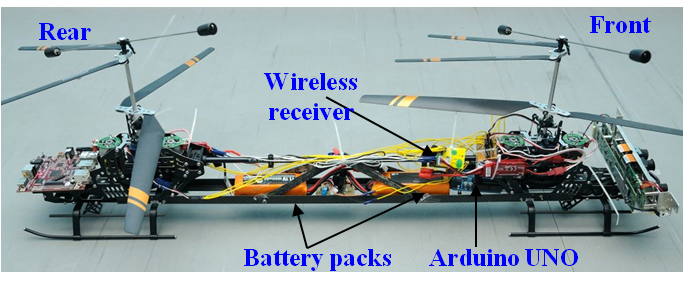
The vehicle shown above showed strong pitch / yaw coupling which required special attention. Therefore, a regular coaxial was modified to improve its payload capability by replacing stock motors with brushless motors and using longer blades. It was further modified to house stripped down Kinect, a quad core single board computer to achieve realtime obstacle avoidance. The realtime obstacle avoidance video is shown on the home page.
Inverse Flight Simulation for Helicopter Undergoing Unsteady Manoeuvre
For the steady flight a helicopter is trimmed to maintain the equilibrium condition, this is achieved by evaluating the control angles, tail rotor collective and shaft angles orientation to match a desired helicopter steady state. But for unsteady manoeuvres a time history of control angles, tail rotor collective and shaft angle orientations is needed to achieve a particular trajectory. This process of calculation of pilot inputs required to achieve a particular trajectory or manoeuvre is referred to as inverse simulation. The goal of this work is to develop inverse simulation capability without significant computational penalty.
Design and Development of an Autonomous Tiltrotor Aircraft
Tiltrotors try to bridge the gap between helicopters and aircrafts. A prototype has already been fabricated which has been tested in hover and gliding flights. Transition flights would be tested soon. Next step would involve the challenging task of development of flight control system for autonomous transition from hover to forward flight.
